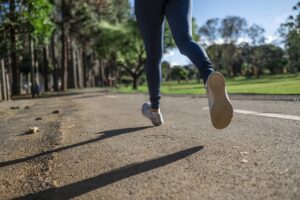GPP RUNNING: THE COMPLETE GUIDE WITH KETTLEBELL
The kettlebell for running GPP?
When we think of running, we often think of the need for good endurance and running technique. However, to improve running performance, it’s also important to work on muscle strengthening and GPP (General Physical Preparedness). These two aspects of training help to strengthen the muscles involved in running, prevent injury and improve posture.
The aim of this article is to present the benefits ofkettlebell training for strength training and GPP in running, and to give advice and practical exercises on how to incorporate it effectively into your training program.
Benefits of muscle strengthening and running GPP
Muscle strengthening and running GPP have numerous benefits for runners in terms of performance, injury prevention and psychological well-being.
From a physical point of view, muscle strengthening and GPP help to improve the runner’s posture. In fact, the back and abdominal muscles are called upon during these exercises, which strengthen the deep muscles and promote better body position during running.
Muscle strengthening and GPP also help prevent injuries. By strengthening the muscles involved in running, notably the quadriceps, glutes, hamstrings and calves, the risk of injury due to muscle weakness is reduced. What’s more, these exercises strengthen muscles specific to running, improving stride efficiency and promoting better endurance.
In addition to these physical benefits, muscle strengthening and GPP also have important psychological benefits for runners. These exercises boost self-confidence, motivation and concentration. By strengthening their bodies and improving their physical condition, runners can be more confident in their ability to achieve their goals. GPP also helps to improve coordination and responsiveness, which in turn improves concentration and efficiency during the race.
The kettlebell: the best tool for running GPP
Running is a discipline that requires good endurance, excellent physical condition and optimal running technique. To achieve these goals, runners often seek to diversify their training and integrate new exercises into their physical preparation program. This is where kettlebells come in handy.
Kettlebells are round-shaped weights with a handle, enabling a wide variety of muscle-strengthening and cardio exercises. The benefits of using kettlebells for experienced runners are numerous. The kettlebell is an effective and versatile option when it comes to weight training equipment for GPP and strength training for running.
Here are some of the specific benefits of using the kettlebell for runners:
Work on stabilizing muscles :
Kettlebell exercises work the body’s stabilizing muscles, which are essential for runners. Good body stability reduces the risk of injury and improves the quality of the run.
Strengthening leg muscles :
The kettlebell helps strengthen leg muscles, particularly the quadriceps, hamstrings and glutes. These muscles are essential for running, as they are called upon during every stride.
Posture Improvement:
Kettlebell exercises strengthen the muscles of the back, shoulders and neck, which can help improve a runner’s posture. Good posture helps you breathe easier, reduce fatigue and improve running performance.
Time-saving :
Kettlebell exercises are generally combined movements that work several muscle groups at the same time. This allows you to achieve an effective workout in less time, which can be very useful for runners with busy schedules.
Variety of exercises :
The kettlebell offers a wide variety of exercises, enabling you to work different muscle groups and vary your workouts. This can help avoid monotony and maintain motivation over the long term.
In conclusion, using the kettlebell for GPP and strength training on the run offers many advantages, including leg muscle strengthening, improved posture and the variety of exercises available. Runners can therefore benefit from adding the kettlebell to their training program.

Basic principles of running GPP with kettlebell
The use of kettlebells for strength training in running requires certain basic principles to be followed to avoid injury and maximize benefits. Here are a few principles to keep in mind:
Start with light weights:
Kettlebells can be more difficult to use than dumbbells or traditional weight machines. It is therefore important to start with light weights to familiarize yourself with the movements and avoid injury.
Working on basic movements :
Basic movements with kettlebells, such as the swing and the turkish get-up, are the foundations of physical preparation with these weights. It’s important to master them before moving on to more advanced exercises.
Maintain correct posture:
When using kettlebells, it’s important to maintain correct posture to avoid injury. This means keeping your back straight, your back and abdominal muscles engaged, and your body weight centred on your feet.
Work with a comfortable range of motion:
Each person has a different level of mobility and flexibility, so it’s important to work within a comfortable range of motion to avoid injury. If a movement is painful, stop and seek professional medical advice.
By following these basic principles, runners can get the most out of using kettlebells for their running training. Kettlebells are an effective way to work on endurance, muscle strengthening, running technique and power, as a complement to running itself.
Kettlebell exercises in running GPP
There are several types of kettlebell exercise that can help runners improve their physical preparation for running. Here are a few examples of exercises to consider:
- The swing: this exercise builds explosiveness in the hips, and strengthens the muscles of the buttocks, lower back and legs. It is also effective for improving posture and body alignment.
- The goblet squat: this exercise strengthens leg, gluteal and back muscles while improving stability and balance.
- The clean and press: this exercise improves coordination, strength and power, while working several muscle groups, including shoulders, arms, back, glutes and legs.
- The renegade row: this exercise strengthens back, shoulder, arm and abdominal muscles, while improving spinal stability and posture.
- The turkish get-up: this all-round exercise builds strength, stability, mobility and coordination throughout the body.
It is important to note that these exercises should not completely replace running, but rather be used as a complement to improve the runner’s overall physical preparation. It is also important to integrate them into a balanced physical preparation program to avoid muscular imbalances and injuries.
By following the basic principles and choosing the right exercises, runners will be able to make the most of kettlebells as part of their general physical preparation for running, improve their performance and reduce the risk of injury.

GPP and kettlebell running strength training program
Here’s an example of a kettlebell running strength and GPP program, spread over two typical weeks, with two sessions per week. You can repeat this cycle 3 to 4 times, for a total of 6 to 8 weeks of training.
Week 1 – Session 1 :
Warm-up: 10 minutes of light jogging
Goblet squat: 3 sets of 12 repetitions
Swing: 3 sets of 15 repetitions
Russian twist: 3 sets of 20 repetitions
Light stretching
Week 1 – Session 2 :
Warm-up: 10 minutes of light jogging
Deadlift: 3 sets of 10 repetitions
Forward lunge: 3 sets of 10 repetitions on each side
One-handed push-ups on kettlebell: 3 sets of 8 repetitions on each side
Light stretching
Week 2 – Session 1 :
Warm-up: 10 minutes of light jogging
Clean and press: 3 sets of 8 repetitions on each side
Jump squat: 3 sets of 10 repetitions
Side plank: 3 sets of 30 seconds each side
Light stretching
Week 2 – Session 2 :
Warm-up: 10 minutes of light jogging
Snatch: 3 sets of 8 repetitions on each side
Goblet squat: 3 sets of 10 repetitions
Side chest curls : 3 sets of 15 repetitions on each side
Light stretching
It’s important to note that this program is an example and can be adapted to suit the physical condition and goals of each individual runner. It’s also important to allow sufficient recovery time between each set, and to warm up before each session. Finally, we recommend varying the exercises and progressing by increasing the load or number of repetitions as you go along.
Other articles that might interest you:
- MMA physical preparation with kettlebell
- Tennis physical preparation with kettlebell
- Military training with kettlebell
- Abs exercises with kettlebell
- WOD with kettlebell in CrossFit
- Bodybuilding with kettlebell
- Kettlebell exercises for women
- Kettlebell HIIT
- Kettlebell sport : all you need to know
- Skiing physical preparation with kettlebell
- Handball physical preparation with kettlebell
- Basketball physical preparation with kettlebell
- Rugby physical preparation with kettlebell
- Football physical preparation with kettlebell
Sources :
- https://conseilsport.decathlon.fr/progresser-grace-a-la-preparation-physique-generale
- https://www.running-addict.fr/conseil-running/10-exercices-de-preparation-physique-generale-ppg-a-faire-a-la-maison/

